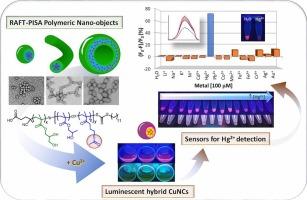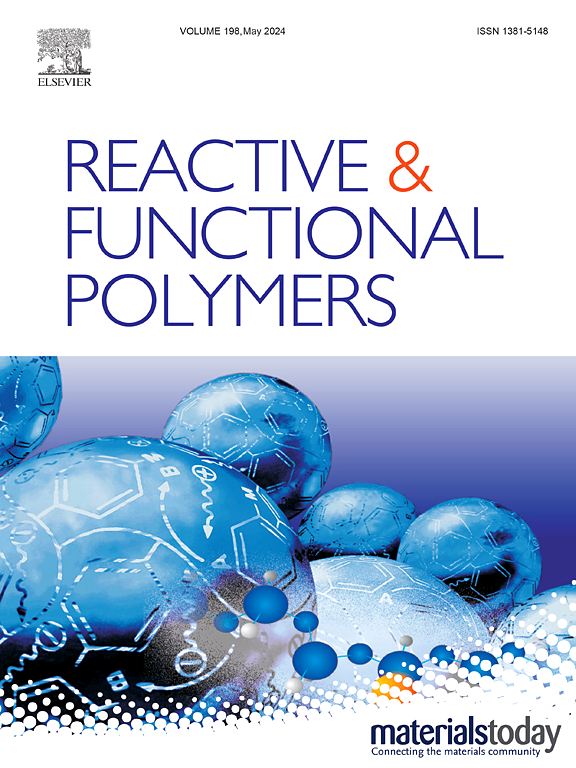发光纳米铜簇 (CuNC) 上的硫醇化 RAFT-PISA 纳米模板用于选择性汞 (II) 检测
IF 5.1
3区 工程技术
Q1 CHEMISTRY, APPLIED
引用次数: 0
摘要
在本研究中,我们通过在疏水嵌段中加入带有受保护硫醇基团-2-(乙酰硫)乙基甲基丙烯酸酯(AcSEMA)的共聚单体,对由 RAFT 介导的 PISA 衍生出的最典型共聚物之一--聚(甲基丙烯酸甘油酯)-b-聚(甲基丙烯酸羟丙酯)(pGMA-b-pHPMA)进行了改性,从而扩大了聚合诱导自组装(PISA)的范围。pGMA-b-p(HPMA-co-AcSEMA) 的光引发合成是在水/乙醇混合物(60/40 v/v)中进行的,以增加 AcSEMA 的溶解度。因此,这种改性可形成多种聚合物纳米形态,如球形、蠕虫形和囊泡形,这取决于亲水和疏水嵌段比例与 AcSEMA 含量之间的平衡。此外,硫醇基团具有很强的金属亲和性,这使得将 AcSEMA 加入自组装纳米结构成为生成先进混合材料的多功能平台,在生物医学、传感、催化或水净化等领域具有潜在的应用前景。这项工作证明,将硫代乙酸酯基团水解为硫醇后,可以使用聚合物纳米物体作为模板,激发功能化纳米铜簇(CuNCs)的发光。这些由数个到数百个铜原子组成的聚合物 CuNCs 发出了显著的红色光,使合成的混合物有望成为发光探针,用于开发高选择性的 "开关式 "发光传感器,以检测 Hg2+。这项工作为设计具有先进应用的多功能杂化纳米材料铺平了道路。本文章由计算机程序翻译,如有差异,请以英文原文为准。

Thiolated RAFT-PISA nano-templates power on luminescent copper nanoclusters (CuNCs) for selective mercury (II) detection
In this study, we expand the scope of polymerization-induced self-assembly (PISA) by modifying one of the most prototypical copolymers derived from RAFT-mediated PISA, poly(glycerol methacrylate)-b-poly(hydroxypropyl methacrylate) (pGMA-b-pHPMA), by incorporating a comonomer with a protected thiol group-2-(acetylthio)ethyl methacrylate (AcSEMA) into the hydrophobic block. The photoinitiated synthesis of pGMA-b-p(HPMA-co-AcSEMA) was conducted in a water/ethanol mixture (60/40 v/v) to increase the solubility of AcSEMA. Thus, this modification enabled the formation of diverse polymeric nano-morphologies such as spheres, worms, and vesicles, dictated by the balance between hydrophilic and hydrophobic block ratios and the AcSEMA content. Besides, the strong metal affinity of thiol groups makes the incorporation of AcSEMA into self-assembled nanostructures a versatile platform for generating advanced hybrid materials with potential applications in biomedicine, sensing, catalysis, or water purification. As evidenced in this work, the post-hydrolysis of the thioacetate group into thiol allowed the use of polymeric nano-objects as templates to power on the luminescenece of functionalized copper nanoclusters (CuNCs). These polymeric CuNCs, composed of several to hundreds of copper atoms, exhibit remarkable red emission, positioning the synthesized hybrids as promising luminescent probes for the development of highly selective “switch-off” luminescent sensors for Hg2+ detection. This work paves the way for the design of multifunctional hybrid nanomaterials with advanced applications.
求助全文
通过发布文献求助,成功后即可免费获取论文全文。
去求助
来源期刊

Reactive & Functional Polymers
工程技术-高分子科学
CiteScore
8.90
自引率
5.90%
发文量
259
审稿时长
27 days
期刊介绍:
Reactive & Functional Polymers provides a forum to disseminate original ideas, concepts and developments in the science and technology of polymers with functional groups, which impart specific chemical reactivity or physical, chemical, structural, biological, and pharmacological functionality. The scope covers organic polymers, acting for instance as reagents, catalysts, templates, ion-exchangers, selective sorbents, chelating or antimicrobial agents, drug carriers, sensors, membranes, and hydrogels. This also includes reactive cross-linkable prepolymers and high-performance thermosetting polymers, natural or degradable polymers, conducting polymers, and porous polymers.
Original research articles must contain thorough molecular and material characterization data on synthesis of the above polymers in combination with their applications. Applications include but are not limited to catalysis, water or effluent treatment, separations and recovery, electronics and information storage, energy conversion, encapsulation, or adhesion.
 求助内容:
求助内容: 应助结果提醒方式:
应助结果提醒方式:


